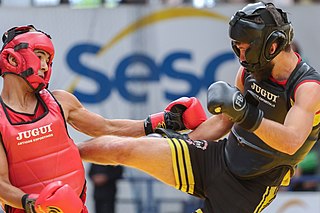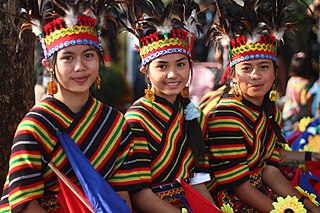
Kickboxing is a group of stand-up combat sports and a form of boxing based on kicking and punching. The combat takes place in a boxing ring, normally with boxing gloves, mouthguards, shorts, and bare feet to favor the use of kicks. Kickboxing is practiced for self-defense, general fitness, or for competition. Some styles of kickboxing include Japanese kickboxing, French kickboxing, Chinese kickboxing and Thai kickboxing.
Martial arts are codified systems and traditions of combat practiced for a number of reasons such as self-defense; military and law enforcement applications; competition; physical, mental, and spiritual development; entertainment; and the preservation of a nation's intangible cultural heritage.

Filipino martial arts (FMA) refer to ancient and newer modified fighting methods devised in the Philippines. It incorporates elements from both Western and Eastern Martial Arts, the most popular forms of which are known as Arnis, Eskrima, and Kali. The intrinsic need for self-preservation was the genesis of these systems. Throughout the ages, invaders and evolving local conflict imposed new dynamics for combat in the islands now making up the Philippines. The Filipino people developed battle skills as a direct result of an appreciation of their ever-changing circumstances. They learned often out of necessity how to prioritize, allocate and use common resources in combative situations. Filipinos have been heavily influenced by a phenomenon of cultural and linguistic mixture. Some of the specific mechanisms responsible for cultural and martial change extended from phenomena such as war, political and social systems, technology, trade and practicality.

Arnis, also known as Kali or Eskrima/Escrima, is the national martial art of the Philippines. The three are roughly interchangeable umbrella terms for the traditional martial arts of the Philippines, which emphasize weapon-based fighting with sticks, knives, bladed weapons, and various improvised weapons, as well as "open hand" techniques without weapons.
Dumog is the Filipino style of wrestling while standing upright and refers to the grappling aspect of Filipino martial arts. The word dumog is most commonly used in Mindanao and the Visayas, while the word buno is used in Luzon, specifically in the Southern Tagalog-speaking provinces as far south as Mindoro. Tribal groups such as the Ifugao, Samal, Ibanag, Manobo, Dumagat, and Maranao are said to practice grappling arts known respectively as bultong, silaga, dama, garong, buteng, purgos, and kapulubod; while ethnic groups such as the Tagalog, Ilokano, Cebuano, Bicolano, Pampanga, and Pangasinan, are said to practice grappling arts known as gabbo, layung, lampugan, pantok, balsakan, and dumog.

Sanda, formerly Sanshou, also known as Chinese boxing or Chinese kickboxing, is the official Chinese full contact combat sport. Sanda is a fighting system which was originally developed by the Chinese military based upon the study and practices of traditional kung fu and modern combat fighting techniques; it combines boxing and full-contact kickboxing, which includes close range and rapid successive punches and kicks, with wrestling, takedowns, throws, sweeps, kick catches, and in some competitions, even elbow and knee strikes.

A bolo is a large cutting tool of Filipino origin similar to the machete. It is used particularly in the Philippines, the jungles of Indonesia, Malaysia and Brunei, as well as in the sugar fields of Cuba.

Sambo is a Soviet-origin Russian martial art, an internationally practiced combat sport, and a recognized style of amateur wrestling included by UWW in the World Wrestling Championships along with Greco-Roman wrestling and freestyle wrestling.
A combat sport, or fighting sport, is a competitive contact sport that usually involves one-on-one combat. In many combat sports, a contestant wins by scoring more points than the opponent, submitting the opponent with a hold, disabling the opponent, or attacking the opponent in a specific or designated technique. Combat sports share a long pedigree with the martial arts.

Kombatan is a Filipino martial arts system. The founder of the system was GGM Ernesto Amador Presas. The current head of the system is Ernesto Presas Jr. The style is known for its double stick techniques, but it features other stick and blade techniques, as well as empty-hand methods.

A folk wrestling style is any traditional style of wrestling, which may or may not be codified as a modern sport. Most cultures have developed regional forms of grappling.

The lei tai is an elevated fighting arena, without railings, where often fatal weapons and bare-knuckle martial arts tournaments were once held. "Sanctioned" matches were presided over by a referee on the platform and judges on the sides. Fighters would lose if they surrendered, were incapacitated, or were thrown or otherwise forced from the stage. The winner would remain on the stage unless ousted by a stronger opponent. If there were no more challengers, they would become the champion. Private duels on the stage had no rules and were sometimes fought to the death.
This martial arts timeline is designed to help describe the history of the martial arts in a linear fashion. Many of the articles for particular styles have discussions of their history. This article is designed to help visualize the development of these arts, to help better understand the progression of the separate styles and illustrate where they interrelate.

The Ifugao people are the ethnic group inhabiting Ifugao Province. They reside in the municipalities of Lagawe, Aguinaldo, Alfonso Lista, Asipulo, Banaue, Hingyon, Hungduan, Kiangan, Lamut, Mayoyao, and Tinoc. The province is one of the smallest provinces in the Philippines with an area of only 251,778 hectares, or about 0.8% of the total Philippine land area. As of 1995, the population of the Ifugaos was counted to be 131,635. Although the majority of them are still in Ifugao province, some of them have moved to Baguio, where they work as woodcarvers, and to other parts of the Cordillera Region.
Arthur Alvin A. Aguilar is a Filipino martial artist and mixed martial arts promoter better known as Alvin Aguilar. He was born on April 28, 1974 in Bacolod, Philippines. He is the president and founder of the Universal Reality Combat Championship (2002–present); He is also the founder and head coach of DEFTAC Ribeiro Jiu-jitsu Philippines (1996–present.) and is currently serving as the president of the Wrestling Association of the Philippines. He started training in martial arts at the age of 9, first in Karate, Arnis and Greco-Roman wrestling. Having spent over 30 years of his life to the study of multiple martial arts forms including Sari-an, Brazilian jiu-jitsu, Yaw-Yan, Pekiti Tirsia Kali, etc., he has developed his own unique fighting style specialized in grappling, knife, and street fighting. He is also known for being the first home-grown Filipino Brazilian jiu-jitsu black belt.

Belt wrestling is a form of wrestling that is one of the oldest historically recorded sports. It involves two belted contestants aiming to take each other over by grappling with a belt. There are hundreds of national belt wrestling styles, but contemporary most widespread and internationally competed are Alysh and Kurash, developed by the previously nomadic Turkic peoples of Central Asia. United World Wrestling recognized Alysh wrestling as the primary international belt wrestling style. It is regulated globally by the International Federation of Wrestling on Belts Alysh, the sport's governing body. Although the sport has been practiced for millennia, and local championships were held in various places of the world, it was until 2001 when Bayaman Erkinbayev started its international version, and it was called "Alysh". Until 2005, Rif Gaynanov and Bayaman Erkinbayev developed this style together, and then the ways separated. Two different styles appeared named "Alysh" and "Kurash" belt wrestling. Since then, the sport has been included in the 2013 Summer Universiade program, recognized by the Asian Olympic Council, and contested at the Asian Games and Asian Indoor Games. The sport's executives struggle to promote it to the level of an official Olympic sport.
Arnis in popular culture reflects the impact that the Filipino martial arts of Arnis/Eskrima/Kali have made outside of the martial arts community. The three terms are roughly interchangeable and for the purpose of convenience, the term Arnis will be used throughout the article. These arts emphasize weapon-based fighting with sticks, blades, improvised weapons and hand-to-hand fighting which is formally known as Mano Mano or Pangamut. Because of this training with live weapons, elements of Arnis have made an impact in film, video games, television, and comic books. Arnis is often used to train actors and stuntmen how to handle similar weapons for use in movies.
The Pilipinas Sambo Federation Inc. (PSFI) is the national governing body of the Russian martial arts of sambo in the Philippines and is a member of Fédération Internationale de Sambo (FIAS) & SAMBO Unnion of Asia (SUA).










